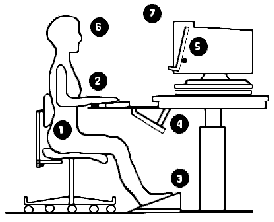![[Currents header graphic]](/homeart/currents_header.gif)
![[Currents header graphic]](/homeart/currents_header.gif)

|
|
Proper workstation setup. Information available on EH&S Web page
|
When Henry Hooker's left forearm started hurting in the spring of 1996, he had no idea what was causing the pain.
"I didn't know what to make of it," says Hooker, a senior architect at UCSC. "I think I mentioned it to my doctor in passing and he said it sounded like some kind of 'Carpal Tunnel' thing."
Luckily for Hooker, he didn't have Carpal Tunnel Syndrome--a condition where inflamed tissues in the wrist squeeze and damage the main nerve extending to the hand.
What he did have, however, was a repetitive strain injury like Carpal Tunnel, caused by his computer use.
Once almost solely the bane of assembly-line workers, laborers, and others in physically demanding jobs, repetitive strain injuries have spread throughout the contemporary workforce. The repetitive key tapping and mouse moving associated with computer use, it turns out, can be just as debilitating as lifting boxes day after day.
From the factory floor to executive offices, repetitive strain injuries are one of the fastest-growing kinds of workplace injuries. These account for half of the workplace injuries at UCSC, with increasing numbers associated with computer use.
"We generally consider a task 'high risk' when it involves two or more hours of continuous repetitive motion without a break, or four or more hours of repetitive motion a day," said Ilse Kolbus, director of Environmental Health & Safety (EH&S).
"Continuous typing or 'mousing' on a computer is a common example of a high-risk activity. The risk is compounded if the person also continues the same motions using a home computer."
A computer user working on an improperly set up workstation can inflame or sprain joints, muscles, ligaments, tendons, or tendon sheaths in the hands, arms, shoulders, or neck. Permanent nerve damage can be the result if injuries aren't properly tended.
"Mild symptoms are the body's way of warning us that we are at risk of serious injury," said Kolbus. "We need to pay attention to these warnings and take action to prevent injury."
Symptoms include pain, stiffness, tingling or numbness in the hands, arms, shoulders, or neck. Many hours spent sitting in an inadequate chair can cause lower back pain. Hours spent at the computer can cause headaches or blurred vision.
Symptoms can appear long after the workday is over, said Kolbus. "You may wake up with tingling in your hands, or your arm might go numb when you're driving."
Kolbus encourages employees who are experiencing problems to let their supervisors know immediately. "It should be dealt with just as any other workplace injury," she said.
Not every computer user will develop these problems, said Kolbus. Physical fitness, muscle tension, habits at work and at home, and stress levels all determine who may get a repetitive strain injury.
A workstation that is "ergonomically correct"--that fits both its user and the task--can go a long way toward preventing repetitive strain injuries. EH&S not only examines workstations and recommends changes, it also is offering monthly classes to teach UCSC staff to avoid computer-related injuries (see schedule).
Although solving some problems may mean purchasing new equipment or adjusting an employee's job duties, many solutions are simple and inexpensive.
Making a workstation fit its user may be as simple as putting a phone book under a monitor to raise it, using a file folder full of papers as a footrest, or moving the computer screen away from the user, Kolbus said.
Leaving the computer for five minutes every hour can also help prevent problems. Refocusing on something beyond the screen for a few seconds every five to ten minutes can alleviate eyestrain. Keeping wrists in a relaxed, neutral position when typing will reduce pressure and stress on the joints and tendons.
For Henry Hooker, the solution was simple: He purchased a tray to lower and extend his keyboard, on the recommendation of EH&S.
"As if by magic my symptoms disappeared in days or weeks," said Hooker, who added that the pain hasn't returned. "It was very clear what was going on."
A campus task force is developing recommendations for a campuswide program aimed at reducing the frequency and severity of computer-related repetitive strain injuries. The Injury Prevention Task Force, with representatives from EH&S, Student Health Services, Insurance & Risk Management, Vocational Rehabilitation, and Purchasing, is nearly finished with its preliminary recommendations.
For more information on each of the topics below, go to
Computer workstation design
Computer and desk stretches
What you should know to protect your wrists from injury
Training videos